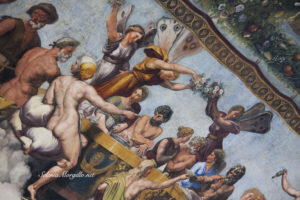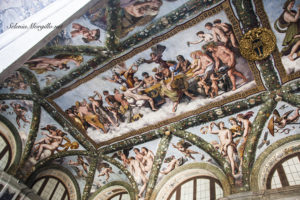The Loggia of Cupid and Psyche by Raphael
Italian Version below*
Agostino Chigi, a banker of Sienese origins and among the richest in Europe, in 1506 entrusted Baldassarre Peruzzi with the construction of a suburban villa, now known as Villa Farnesina alla Lungara.
A temple of delights, idleness, and a triumph of Love, this was the intent of the patron who commissioned the decoration of one of the main rooms to the genius of Raphael.
The future Loggia of Cupid and Psyche was to be a place of ineffable beauty to welcome and amaze the illustrious guests.
Raphael transforms the vault of the loggia into a pergola where takes place, Cupid and Psyche Love Story crossed by large vegetable festoons which recognize the first fruits and flowers imported from America by Colombo (pumpkins, aubergines, corn), to the testimony of the modernity of Chigi.
A love story, taken from Golden Donkey Apuleio’s, in which a young girl will fall victim to Cupid who will fall in love with her and decide to marry her.
In the center of the vault, as in two fake tapestries, the artist represents the Council of the Gods and the Wedding Banquet; on the sides all the most important deities, Jupiter with Ganymede, Mercury.
The theme is a transposition of the sentimental life of Chigi, who has long been in love with a courtesan, Francesca Ordeaschi whom she had met in Venice and with whom she will have 5 children.
In 1518, the year of decoration of the vault, Agostino was preparing the wedding with Francesca, which took place in 1519 with the consent of Pope Leo X.
The whole project is the work of Raphael who made use of his workshop, however, it is possible to recognizes interventions by Giulio Romano and Giovanni da Udine (for the pergola).
The chronicles tell that Raphael was unable to complete the job because he missed his beloved, the famous Fornarina, pseudonym of Margherita Luti, daughter of a baker from Trastevere … and so the good Agostino seems to have had her transferred to the Villa to speed up the decorations.
Furthermore, it is probable that the initial project involved the realization of the terrestrial scenes on the walls (now occupied by fake niches), but the addition of Raphael’s death in 1520 did not allow the conclusion of the pictorial cycle.
All rights reserved*
Agostino Chigi, banchiere di origini senesi e tra i più ricchi d’Europa, nel 1506 affida a Baldassarre Peruzzi la costruzione di una villa suburbana, oggi nota come Villa Farnesina alla Lungara.
Un tempio di delizie, di ozio ed un trionfo dell’Amore, questo era l’intento del mecenate che commissionò al genio di Raffaello la decorazione di uno degli ambienti principali.
La futura Loggia di Amore e Psiche doveva essere un luogo di ineffabile bellezza per accogliere e stupire gli illustri ospiti.
Raffaello trasforma la volta della loggia in un pergolato in cui avviene la Storia d’Amore di Cupido e Psiche attraversato da grandi festoni vegetali in cui si riconoscono i primi frutti e fiori importati dall’America da Colombo (zucche, melanzane, mais), a testimonianza della modernità del Chigi.
Una storia d’amore, tratta dall’Asino d’Oro di Apuleio, in cui una giovane ragazza cadrà vittima di Cupido che si innamorerà di lei e deciderà di sposarla. Al centro della volta, come in due finti arazzi, l’artista rappresenta il Concilio degli Dei ed il Banchetto Nunziale; ai lati tutte le divinità più importanti, Giove con Ganimede, Mercurio. Il tema è una trasposizione della vita sentimentale del Chigi, innamorato da tempo di una cortigiana, Francesca Ordeaschi che aveva conosciuto a Venezia e da cui avrà 5 figli.
Nel 1518, anno di decorazione della volta, Agostino stava preparando le nozze con Francesca, avvenute nel 1519 con il consenso di Papa Leone X.
Tutto il progetto è opera di Raffaello che si avvalse però della sua bottega, si riconoscono interventi di Giulio Romano e Giovanni da Udine (per il pergolato).
Raccontano le cronache che Raffaello non riuscisse a portare a termine il lavoro perché sentiva la mancanza della sua amata, la celebre Fornarina, pseudonimo di Margherita Luti, figlia di un fornaio di Trastevere… e così il buon Agostino sembra che l’avesse fatta trasferire nella Villa per accelerare le decorazioni.
Inoltre, è probabile che il progetto iniziale prevedesse la realizzazione delle scene terresti sulle pareti (oggi occupate da finte nicchie), ma la sopraggiunta morte di Raffaello nel 1520 non consentì la conclusione del ciclo pittorico.
Sostieni #laculturachevince, aiuta la condivisione.
InfoSite: Villa Farnesina


One Reply to “The Loggia of Cupid and Psyche by Raphael”
Gli affreschi di Raffaello lasciano senza fiato e apprezzarli con la compagnia di Selenia e del suo amore per l’ arte è stata una bellissima esperienza.
Grazie !